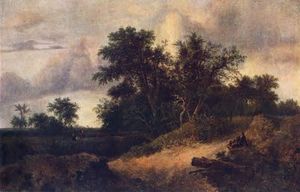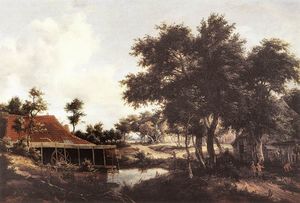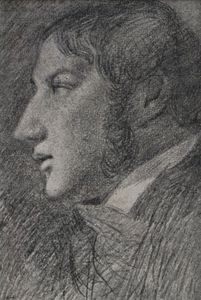Jacob van Ruisdael
- Full Name:
- Jacob Isaakszoon van Ruisdael
- Short Name:
- Ruisdael
- Date of Birth:
- 1628
- Date of Death:
- 14 Mar 1682
- Focus:
- Paintings
- Mediums:
- Oil, Wood, Other
- Subjects:
- Landscapes
- Art Movement:
- Baroque
- Hometown:
- Haarlem, Netherlands
- Living In:
- Amsterdam, Netherlands
- Jacob van Ruisdael Page's Content
- Introduction
- Artistic Context
- Biography
- Style and Technique
- Who or What Influenced
- Works
- Followers
- Critical Reception
- Bibliography
Introduction
Jacob van Ruisdael is considered one of the great masters of landscape painting. Drawing inspiration from his surroundings and from the stories of incoming travelers, he created paintings that evoked emotion and thought. Van Ruisdael also used his imagination to create dramatic scenes and some of the most astounding landscape art works ever produced.
The artist took landscape painting to a new level by creating nature as a metaphor of human psychology, specifically its darker aspects. Through the work of Jacob van Ruisdael landscape painting was no longer simply a record of how nature was perceived but rather it came to symbolize a deeper aspect that reflected the very soul of humankind.
Derived from the Classical style, van Ruisdael paved the way for the Romantic style that came about in the late 18th century. His romantic mood is evident in his depiction of nature as he creates beautiful and tumultuous interpretations of the weather. Van Ruisdael recreated images, objects and structures amidst the vast horizons that created a sense of escapism in their dreamlike portrayal.
Jacob van Ruisdael Artistic Context
Dutch Baroque has become the most noted era in art. Artists were able to freely choose their subject matter and how they wanted to express it and this resulted in artists creating new art styles and techniques. Thus, the Dutch were prospering not only socially and economically but also in their art and culture.
Deriving the Baroque style from Italy, the predominantly Protestant Dutch society would not allow the presentation or idolization of religious or biblical figures in paintings, instead favoring more conservative themes. This resulted in the Dutch focusing on more realistic painting and defining new concepts in portraiture, characterization, landscapes and still life.
As the 17th century came to a close, more Protestant countries rejected Catholicism and a new art style was created that was more dramatic and revolutionary. This style was known as Rococo.
Jacob van Ruisdael Biography
Very little is known about Jacob van Ruisdael's personal and professional relationships as he did not keep any journals of his travels or personal life. However, it is clear that he was a pioneer of landscape painting and an artist who heavily influenced emerging painters throughout the two centuries following his death.
Formative Years:
As a young boy van Ruisdael's biggest influence was his uncle, Salomon van Ruysdael, who was an acclaimed landscape artist in his own right. Jacob van Ruisdael became a prodigy in landscape painting and outshone his peers.
After completing his studies at the Guild of St Luke in Haarlem, he travelled across the Netherlands and into Germany, drawing inspiration for many of his works, mostly notably Bentheim Castle.
Around 1656 van Ruisdael moved to Amsterdam and he lived there for the rest of his life.
In Amsterdam his painting style changed and he started painting more from imagination rather than reality. Van Ruisdael opened up a very successful studio and took on many students who would define the next generation of landscape painting.
Middle Years:
In the 1670s the French invasion of the Netherlands had dire consequences for the art market and so van Ruisdael decided to train to be a surgeon, graduating in 1676. However, many art historians question whether or not this actually happened.
Advanced Years:
Jacob van Ruisdael lived a prosperous life and died on 14th March 1682 aged about 54.
Jacob van Ruisdael Style and Technique
Eugène Fromentin, 1876
"A canvas by Ruisdael is an
entirety in which we can feel
there is composition, a grasp of
the whole, a master purpose ...
and with a certain contempt for
what is unnecessary, too
agreeable or superfluous, great
taste with great sense ... this is
what one finds on analysing a
picture by Ruisdael."-

Jacob van Ruisdael's greatest artistic skill was his ability to create new aspects in space and dimension when portraying various dramatic elements of nature. He came to perfect the art of landscape painting through his technical competency and innovation.
Strongly influenced by his great uncle, Salomon van Ruysdael, under whom he later studied, van Ruisdael's early offerings show an intense affiliation to nature and the solitary structure and objects against nature's great vastness.
Later on in his career, when in Amsterdam, Jacob van Ruisdael created works derived from his imagination, using the Dutch and Germanic landscapes as a foundation. He would devise all sorts of methods to create new visual aspects such as using new painting techniques for his distant horizons and impasto for three dimensional effects.
Impasto is a thick type of paste that creates astounding lighting affects and reflections. When applied thickly, it can show the intensity of the brush stroke which makes expression easier.
During the 1650s van Ruisdael's palette became brighter and he used lighter shades for the sun-highlighted solitary structures. He also began to use more blues to depict the sky.
Trees and foliage also appear greener in his later works and the images are starker.
Like his uncle, van Ruisdael painted with a keen focus on the effect of light and atmosphere which would ultimately change the natural components of the landscape. Painting his images below a cloudy sky would also alter the dynamic of the image and create new compositional techniques.
Who or What Influenced Jacob van Ruisdael
Jacob van Ruisdael's first major influence was his uncle, Salomon van Ruysdael, his father's brother. Salomon was an avid landscape painter who also studied at the Guild of St Luke in Haarlem.
It's believed that two of Salomon's main influences were friends and fellow Dutch artists Esaias van de Velde and Jan van Goyen.
Salomon van Ruysdael, van de Velde and van Goyen were all inspired by the early Dutch Baroque artist Cornelis Vroom who specialized in landscape painting.
The young Jacob van Ruisdael was influenced by each of these Dutch artists and took their technique and style of landscape painting to the next level.
Second career:
It could be argued that van Ruisdael's life as a surgeon also served as inspiration in finding the precise images to depict the tumult of human life and the changes and emotions defining it.
Nature:
Van Ruisdael must have spent considerable time in and around the Dutch countryside and north-west Germany and he was fascinated by the brutal and barren northern European landscapes.
Allart van Everdingen :
Everdingen was a Dutch landscape artist who was passionate about dark landscapes of the north and would frequently travel to Norway in search of inspiration.
Everdingen's landscapes are full of sweeping clouds, heavy rain and tumultuous ravines. He executes his work on a more intense level, portraying more powerful, overbearing and intense images using a darker palette than that of Ruisdael.
Everdingen's influence is particularly evident in van Ruisdael's Waterfall with Castle Built on the Rock.
Jacob van Ruisdael Works
Jacob van Ruisdael Followers
Jacob van Ruisdael was a popular painter who enjoyed success throughout his career. This was rare as many artists from the Dutch Baroque era experienced great financial hardship. Ruisdael's work as a surgeon meant that he led a prosperous life but it was his art work that gained him most acclaim. Ruisdael's success as both an artist and teacher influenced a new generation of landscape artists.
Meindert Hobbema:
It's believed that Hobbema worked as an apprentice under van Ruisdael when the artist settled in Amsterdam and opened up his studio. Hobbema's work is seen to have the most influence out of all of Ruisdael's followers. Even his subject matter of landscape and objects in nature bares a strong resemblance to that of Ruisdael.
Hobbema became a master in his own right as he depicted fine details and excellence in hedges and woodland pictures. He tended to use an olive green hue in all of his works and liked using intense detailing in the foliage. Like Ruisdael, Hobbema thrived on painting overbearing, foreboding clouds with light penetrating through them for dramatic effect. He would also paint the Dutch countryside with solitary figures to convey the underlying psychological aspect. In the same manner as Ruisdael, Hobbema would have other artists paint and sketch his figures.
John Constable :
John Constable was a renowned British landscape artist. During his time at the Royal Academy he studied the old masters as was the predominant style taught at the school. It was here that Constable also drew inspiration from other great artists of the 17th century such as Carracci, Rubens and Ruisdael. Constable's composition is similar to that of Ruisdael in his depiction of landscapes and his presentation of the subject matter.
Constable would also use weather as a means of evoking mood in his works like Ruisdael did but with a much more intense focus. A clear example of this is in his Stonehenge painting as he portrays the nature in tumult and mystery.
Thomas Gainsborough :
Gainsborough was a British landscape painter and Constable's predecessor. Gainsborough carried van Ruisdael's landscape paints into the Rococo period and was highly influenced by van Ruisdael's choice of subject matter.
Gainsborough went on to become the dominant landscape painter in Britain in his time and gained several commissions from the King. Even in his famous portraits he would insert his trademark landscape in the background and this can be seen in his most famous work, Mr. and Mrs. Andrews.
Romanticism:
Derived from the Classical style, Jacob van Ruisdael paved the way for the Romantic style that came about in the late 18th century. His romantic mood is evident in his depictions of nature as he creates beautiful and tumultuous interpretations of the weather.
The artist also inserted dramatic structures such as castles, storms, mountains and crags to symbolize human conditions in all their beauty and ugliness.
Jacob van Ruisdael Critical Reception
Arnold Houbracken, 1721
"He painted national and foreign landscapes, particularly those in which water was to be seen falling from one to another rock to end noisily ... tumbling down or praying out. He could portray water plashing or foaming as it dashed on the surrounding rocks so naturally, tenderly and transparently, that it seems to be real water."
-

-

Henry Fuseli
Ruisdael's success as both an artist and teacher influenced a new generation of landscape artists throughout the following centuries. He is considered one of the most famous landscape painters of 17th-century Holland and is regarded as the greatest example of the classical phase of Dutch landscape painting.
During Life:
In his early career Jacob van Ruisdael established himself as a prodigy in landscape painting and he produced work that surpassed his contemporaries in this art genre. After moving to Amsterdam to make his mark as an artist, he was soon known among affluent circles in the art world and went on to live a prosperous life. This was somewhat rare given that many artists from the Dutch Baroque era experienced great financial difficulties, particularly following France's invasion of the Netherlands in the 1670s.
After death:
Joshua Reynolds, who became the first President of the Royal Academy in 1768, purchased five of van Ruisdael landscape paintings in the 1750s and this set a trend for other collectors. By the 1780s van Ruisdael was considered a 'must have' artist. Describing van Ruisdael's work Reynolds writes that his landscapes: 'have not only great force but have a freshness scarce seen in any other painter'.
British critics admired van Ruisdael's accuracy and his ability to combine the natural with the sublime. The artisit was also valued for his stormy seascapes. Reynolds bought one of these during a trip to Holland and became a benchmark for emerging artists during the 1790s, often referred to as the 'Picturesque Decade'.
John Constable was a great admirer of van Ruisdael's work and as the son of a country miller he shared and understood the artist's views on nature.
Constable had made a copy of one of van Ruisdael's etchings before beginning his studies at the Royal Academy School but as a student there he would have been exposed to persistent academic contempt for Dutch landscape as mere scenery.
Henry Fuseli, a Professor of Painting at the Royal Academy went as far as to say: 'the tame delineation of a given spot: an enumeration of hill and dale, clumps of trees... what is commonly called views'. However, Constable continued to admire the work of the Dutch artist and even bought one of van Ruisdael's paintings to copy.
Although his influence on other Dutch artists was notable, particularly with regards to his student Hobbema, the importance of van Ruisdael's work was not fully realized until the Romantic period, with the consequent rise of naturalistic landscapes in both England and France. Today, van Ruisdael is regarded as one of the greatest old masters of the 17th century.
Jacob van Ruisdael Bibliography
To find out more about Jacob van Ruisdael and his fascinating work please refer to the sources listed below.
• Buvelot, Quentin. Jacob van Ruisdael: Paints Bentheim. Waanders Publishers, 2010
• Caffin, Charles Henry. The Story of Dutch Painting. Cornell University Library, 2009
• Levey, Michael. Ruisdael: Jacob van Ruisdael and other painters of his family (Themes and painters in the National Gallery : Series 2) National Gallery, 1977
• Slive, Seymour. Jacob van Ruisdael: A Complete Catalogue of His Paintings, Drawings, and Etchings. New Haven: Yale University Press, 2001
• Slive, Seymour. Jacob Van Ruisdael: Master of Landscape. Yale University Press, 2005
• Sotheby's, New York. Important Old Master Paintings and the Borromeo Madonna By Donatello - Volume 1, 2006
• Walford, E. John. Jacob Van Ruisdael and the Perception of Landscape. Yale University Press, 1992































